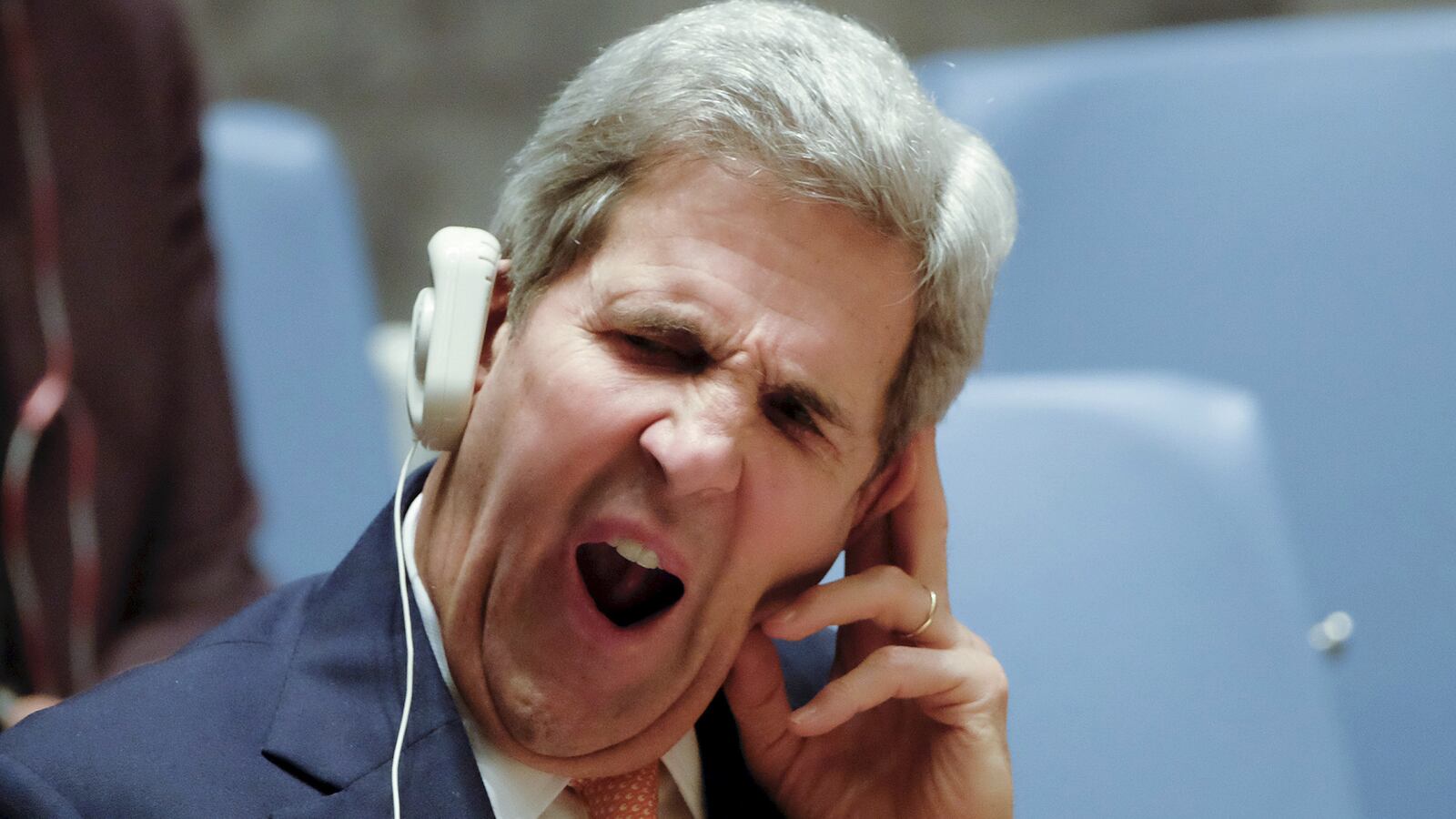To the growing litany of elusive human rewards like the simultaneous orgasm and socialism with a human face we can now add the “nationwide cessation of hostilities.”
Last night, in Munich, the Secretary of State John Kerry outlined a plan for a moratorium on violence in the five year-old civil war in Syria. Actually, the plan isn’t new at all; it had been limned last October in Vienna by its principal architects, Kerry and his Russian counterpart Sergei Lavrov, whose government has serially humiliated the former’s in the last few years. Nor is there anything resembling a civil war to stop in Syria. There are, rather, a proliferating series of sideshow conflicts involving hundreds of different armed factions—including the expeditionary units or special forces of two foreign states—which collectively control all of Syria’s balkanized geography. These factions can be broadly separated into three categories, with some overlapping characteristics. There are those fighting for themselves and their competitive “state-building” projects, including the Kurdish People’s Defense Units and ISIS. There are those fighting for the regime of Bashar al-Assad including Iran’s Revolutionary Guards Corps and an ever expanding circle of its multinational proxies such as Lebanese Hezbollah; the Fatemiyoun Division of Afghan refugees as young as 12 year-olds who have been conscripted in Iran to fight in Syria; the National Defense Force, a super-militia of Shia and Alawite fighters; three Iraqi Shia militias, the Badr Corps, League of the Righteous and Hezbollah Brigades, which have lately returned the favor of receiving American air support in Amerli and Tikrit by attacking the CIA-armed rebels in Aleppo. (The League of the Righteous has also reportedly kidnapped three American contractors in Baghdad). Finally, there are those fighting for the overthrow of the regime including the aforesaid CIA-armed rebels and a host of Islamist or Salafist brigades. The proposed ceasefire, however, will not apply to ISIS, which commands between 20,000 and 30,000 fighters, and one of the stronger elements from the third category, Jabhat al-Nusra, the Syria’s official al-Qaeda franchise, which commands 10,000. ISIS and al-Nusra are undisputed terrorist organizations and so the war against them must continue unabated. But this means that 40,000 well-armed jihadists will be able to shoot and suicide bomb their way through a nationwide cessation of hostilities, facing no resistance from their manifold enemies who will now be duty-bound to lay down their arms and turn the other cheek.
What could possibly go wrong?
Into this simple solution for peace in our time comes the inevitable morass of the peacemakers. Russia has insisted since late September, when its air campaign in Syria got underway, that it is bombing ISIS. It is plainly, demonstrably not. Last week, Pentagon spokesman Col. Steve Warren told reporters that, at most, ten percent of Russian airstrikes have been directed at Abu Bakr al-Baghdadi’s garrisons, weaponry and oil infrastructure, and only then in the rare occasion that agents of the caliphate and agents of Assad collide on the battlefield. The Russian Defense Ministry, however, lies daily about its quarry, as open-source investigators, such as the website Bellingcat, have shown using the ministry’s own uploaded video footage of airstrikes. More frequent casualties of Vladimir Putin’s intervention are, in no particular order of priority, grain silos, hospitals, water-treatment plants, ambulances, mosques, US-backed anti-Assad (and anti-ISIS) rebels, and a thousand civilians and counting.
A week ago, the Syrian White Helmets, a search-and-rescue volunteer corps that pulls men, women and children from the rubble, counted 900 airstrikes in Aleppo’s provincial capital in a single 24-hour period. There is no ISIS in Aleppo City, but Syrian and Russian warplanes have nevertheless been pulverizing it round-the-clock in anticipation of a mounting ground offensive—one led by all the Iranian-built proxies I mentioned earlier—to recapture the Syrian opposition’s last major stronghold. Thirty thousand people have fled to the Turkish border to escape the carnage. No doubt more will follow. Russia, meanwhile, will insist that it is abiding by the ceasefire by going after ISIS—or it will blame the US-led coalition for bombing Aleppo, as it tried to do yesterday.
Assad himself has pressed the obvious point, vowing to retake “all” of his hopelessly balkanized country, whatever pieces of paper get drawn up in Switzerland. “[I]f we negotiate, it does not mean that we stop fighting terrorism,” he told AFP today, using as baggy a definition of the the word terrorism as his Russian and Iranian suzerains do.
The foregoing Mad Hatter scenario is what we can expect if Kerry’s big initiative fails. What happens if it by some miracle succeeds will be even worse. The Syria Institute is a newish nonprofit research organization based in Washington, DC which studies the conflict in granular detail. Along with the Dutch peace group PAX, it has found that over one million Syrians are currently living under a state of siege, the overwhelming majority courtesy of pro-regime forces. Of 52 besieged areas identified by the UN Office for the Coordination of Humanitarian Affairs, only two are held by the armed opposition—the towns of Fuaa and Kefraya, both in in Idlib province. The other exception is Deir Ezzor city, which is held by a combination of ISIS and the Syrian military. “Local ceasefires in besieged communities in Syria have frequently failed to bring an end to the sieges,” the Syria Institute and PAX writes in its latest quarterly report on the subject. “Even in cases where violent attacks cease, humanitarian access is generally minimal, movement restrictions remain, and living conditions do not improve—and sometimes worsen—following ceasefire implementation. UN participation in these agreements, particularly in assisting with forced population transfers, appears to have validated the Syrian government’s strategy of besieging civilians in order to subjugate or depopulate an area.”
That last observation has actually been conceded by the UNOCHR, whose Damascus office has done Assad’s bidding in erasing the words siege or besieged from a blueprint intended to relieve nearly a million people facing starvation. In other words, the gruesome dictatorship that was recently accused by a separate UN body of waging a campaign of “extermination” against tens of thousands of political prisoners, gets to write the terms of how its victims may be saved. “While no single party holds a monopoly on brutality in Syria,” Valerie Szybala, the executive director of the Syria Institute told me, “we must be careful not to equate what the Syrian government has done with that of any other actor. By all conceivable metrics, the Syrian government’s systematic detention, torture, and killing of Syrians throughout the conflict is unparalleled.” Now it can do so with the connivance of Washington.
You really do have to hand it to John Kerry. His energy for diplomacy is now as boundless as his imagination for what it can accomplish, and with whom. At this point, he would do the Syrian people a greater favor by begging off this file and acknowledging that there is indeed a “military solution” to their country’s slow-motion collapse—the one being prosecuted by their adversaries that will render them homeless, orphaned or dead.






